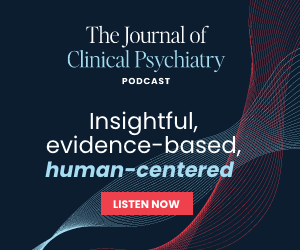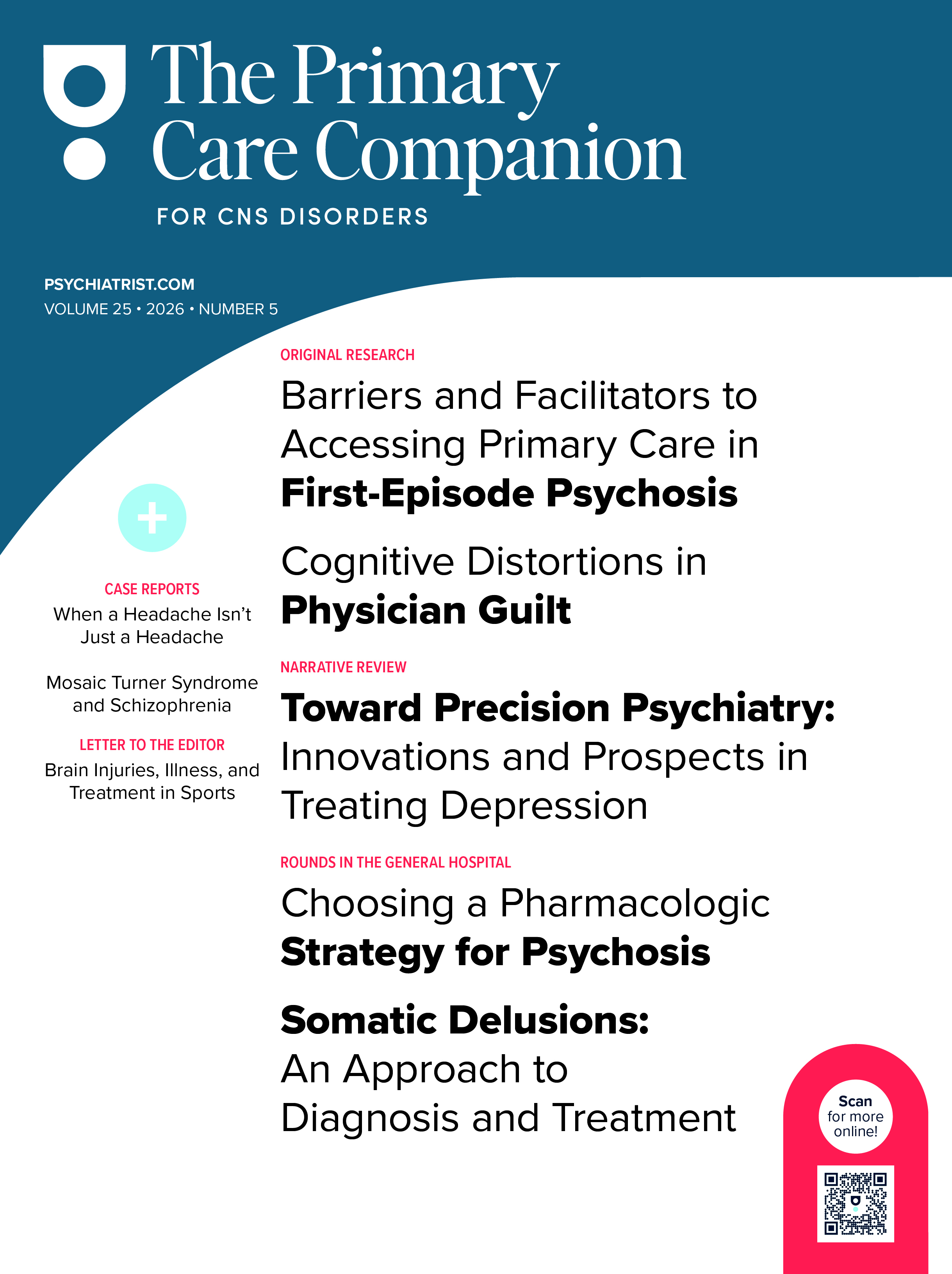One-third of patients with schizophrenia fail to respond to 2 or more nonclozapine antipsychotics.1,2 However, after the first antipsychotic trial fails, less than 20% respond to a second antipsychotic, with declining rates in subsequent trials.3 In antipsychotic nonresponders, early initiation of clozapine is associated with improved response rates, reduced mortality, lower incidence of suicide, and decreased rehospitalization.4–6 Since 40% of such patients respond to clozapine, using it after the first failed antipsychotic trials could have a better outcome.7 We present the case of a patient with schizophrenia with significant aggression who achieved remission with a low dose of clozapine started after the first failed antipsychotic trial.
Case Report
A 25-year-old black man was civilly committed to an inpatient psychiatric hospital due to severe aggression that escalated over 7 months. Initially, he missed work and expressed beliefs about the FBI and his colleagues conspiring to change his sexual orientation. He also vandalized a neighbor’s property, accusing them of controlling his body. These actions led to job loss, eviction, and, eventually, police intervention and hospitalization. He had no previous psychiatric or medical history. He had a sister with schizophrenia, and he occasionally used marijuana. Upon admission, he exhibited pronounced aggression, accusing staff of trying to change his gender and exhibiting paranoid delusions, thought insertion, and auditory hallucinations.
Neuroimaging, complete blood count, and liver and kidney function tests were within normal limits. The urine drug screen was positive for cannabis. His physical examination was unremarkable. He was diagnosed with schizophrenia and initially treated with 10 mg/d of haloperidol. Due to unsuccessful control of his aggression, the dosage was increased to 30 mg/d. In addition, intramuscular lorazepam was administered, and restraint was used for safety.
After 5 weeks with no improvement, haloperidol was changed to clozapine, started at 25 mg/d, and gradually increased to 200 mg/d over 10 days. This adjustment led to a significant reduction in aggressive symptoms within 2 weeks, and his delusions and hallucinations notably diminished by the fourth week. His clozapine level was 180 ng/mL. Adverse effects were closely monitored in the inpatient setting through daily rounds, during which the patient was evaluated for adverse effects. A physical examination was conducted if the patient reported any physical symptoms. The patient was compliant with the weekly blood draws for absolute neutrophil count and exhibited no laboratory evidence of clozapine-induced neutropenia. During the course of treatment, the patient complained of no adverse effects other than hypersalivation, which was managed with sublingual atropine at night.
After 6 weeks of treatment, the patient’s aggression had entirely resolved. A mental status examination revealed no delusion or hallucination, and he engaged actively in therapy and community activities, achieving complete insight into his condition. He was transferred to a step-down unit after being discharged.
Discussion
A second trial with a nonclozapine antipsychotic could potentially extend inpatient stays by 4–6 weeks, yielding only modest potential success. This prolonged hospitalization can adversely impact social skills, increase suicidal ideation due to stigma, and impair productivity.8 Considering the reduced availability of psychiatric beds and the move toward community-based care, using clozapine as a second-line treatment is practical when its advantages substantially outweigh the associated risks.4
Guidelines recommend a clozapine plasma level of 350 ng/mL, yet some patients respond to lower levels.2,9 A Cochrane review found no significant difference in efficacy between low doses (150–300 mg/d) and standard doses (300–600 mg/d) of clozapine.10 However, a meta-analysis indicated that clozapine levels above 350 ng/mL are associated with better responses, although the studies analyzed predominantly involved patients with over 8 years of illness duration.11
It is crucial to balance the potential advantages of clozapine against its known risks, such as agranulocytosis, seizures, myocarditis, and constipation. Because of these risks, clozapine is reserved for resistant cases, in which it is the most effective medication. While mandatory blood testing has reduced the risk of death secondary to agranulocytosis, other adverse effects like constipation and resulting ileus continue to be a major concern, which is probably dose dependent. In a recently published study from Finland, constipation and resulting ileus, along with pneumonia, were the most common causes of death in patients on clozapine followed up for many years.12 Therefore, if started early in cases where the benefits outweigh the risks, it may be possible to use a lower dose—as highlighted in our patient—to lower the adverse effect burden.
In conclusion, while clozapine is traditionally reserved as a third-line treatment, reconsidering it as a second-line option in selected cases where the benefits clearly outweigh the risks after consideration of its adverse effects may reduce hospital stays and lower adverse effect burdens. Further validation through controlled studies is needed.
Article Information
Published Online: February 20, 2025. https://doi.org/10.4088/PCC.24cr03850
© 2025 Physicians Postgraduate Press, Inc.
Prim Care Companion CNS Disord 2025;27(1):24cr03850
Submitted: September 12, 2024; accepted November 8, 2024.
To Cite: Rizvi A, Osenova R, Huh SY, et al. Low-dose clozapine in schizophrenia with aggression after a single failed antipsychotic trial. Prim Care Companion CNS Disord. 2025;27(1):24cr03850.
Author Affiliations: Department of Behavioral Medicine and Psychiatry, West Virginia University, Morgantown, West Virginia (Rizvi); West Virginia School of Osteopathic Medicine, Lewisburg, West Virginia (Osenova, Huh); West Virginia University, Morgantown, West Virginia (Yadava).
Corresponding Author: Abid Rizvi, MD, Department of Behavioral Medicine and Psychiatry, West Virginia University, 936 Sharpe Hospital Rd, Weston, West Virginia 26452 ([email protected]).
Relevant Financial Relationships: None.
Funding/support: None.
Patient Consent: The patient provided written consent to publish this case report, and information has been de-identified to protect anonymity.
ORCID: Aradhita Yadava: https://orcid.org/0009-0003-7995-1246
References (12)

- Hany M, Rehman B, Rizvi A, et al. Schizophrenia. In: StatPearls [Internet]. StatPearls Publishing; 2024. https://www.ncbi.nlm.nih.gov/books/NBK539864/
- Keepers GA, Fochtmann LJ, Anzia JM, et al. The American Psychiatric Association practice guideline for the treatment of patients with schizophrenia. Am J Psychiatry. 2020;177(9):868–872. CrossRef
- Agid O, Arenovich T, Sajeev G, et al. An algorithm-based approach to first-episode schizophrenia: response rates over 3 prospective antipsychotic trials with a retrospective data analysis. J Clin Psychiatry. 2011;72(11):1439–1444. PubMed CrossRef
- Remington G, Agid O, Foussias G, et al. Clozapine’s role in the treatment of first-episode schizophrenia. Am J Psychiatry. 2013;170(2):146–151. PubMed CrossRef
- Varghese MT, Jyothi KS, Shaji KS, et al. Delaying clozapine: how long is too long? Gen Psychiatr. 2020;33(2):e100172. PubMed
- Taipale H, Tanskanen A, Mehtälä J, et al. 20-year follow-up study of physical morbidity and mortality in relationship to antipsychotic treatment in a nationwide cohort of 62,250 patients with schizophrenia (FIN20). World Psychiatry. 2020;19(1):61–68. PubMed CrossRef
- Lieberman JA, Safferman AZ, Pollack S, et al. Clinical effects of clozapine in chronic schizophrenia: response to treatment and predictors of outcome. Am J Psychiatry. 1994;151(12):1744–1752. PubMed CrossRef
- Carranza Navarro F, Álvarez Villalobos NA, Contreras Muñoz AM, et al. Predictors of the length of stay of psychiatric inpatients: protocol for a systematic review and meta-analysis. Syst Rev. 2021;10(1):65. PubMed CrossRef
- Rizvi A, Reyazuddin M, Shaan F. Low-dose clozapine in early-onset resistant schizophrenia: case report and 2-year follow-up. J Am Acad Child Adolesc Psychiatry. 2023;62(8):839–841. PubMed CrossRef
- Subramanian S, Völlm BA, Huband N. Clozapine dose for schizophrenia. Cochrane Database Syst Rev. 2017;6(6):CD009555. PubMed CrossRef
- Siskind D, Sharma M, Pawar M, et al. Clozapine levels as a predictor for therapeutic response: a systematic review and meta-analysis. Acta Psychiatr Scand. 2021;144(5):422–432. PubMed CrossRef
- partanen JJ, Häppölä P, Kämpe A, et al. High burden of ileus and pneumonia in clozapine-treated individuals with schizophrenia: a Finnish 25-year follow-up register study. Am J Psychiatry. 2024;181(10):879–892. PubMed CrossRef
Please sign in or purchase this PDF for $40.





